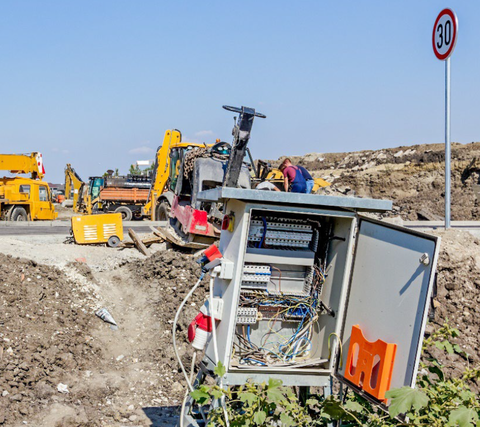Using poorly maintained or out of date electrical equipment in dangerous environments exposes workers and visitors to the risk of electric shock, particularly hazardous when in direct contact with ground.

UK construction – It’s a tough life
Using poorly maintained or out of date electrical equipment in dangerous environments exposes workers and visitors to the risk of electric shock, particularly hazardous when in direct contact with ground.
RCDs are relied on to provide additional and fault protection. Many existing distribution boards installed on UK construction sites contain Type AC RCDs.
Type AC RCDs are are not suitable for use with majority of modern electrical equipment and tools used on construction sites, with the exception of resistance based heating and lighting loads - See BS7671 Amendment 2.
BS7671 Amd. 2: 704.41 Protection against electric shock
The general requirements of this regulation refer back to the main body of the regulations for automatic disconnection of the supply. Amendment 2 at the end of regulation 531.3.3 states; “RCD Type AC shall* only be used to serve fixed equipment, where it is known that the load current contains no DC components.”
Controlling and managing the suitability of equipment that is connected to the site supply, particularly with regard to plug-in equipment is a major challenge for health and safety. The risk associated with connecting 3 phase equipment, to an existing supply protected by the incorrect Type of RCD is a potential hazard present on all UK sites. This is recognised and addressed in HD 60364-7-704 2018 Annex ZB: On German construction and demolition sites / All 3 three-phase sockets up to 63 A must be protected by Type B RCDS.
Temporary Installations: Any equipment disconnected and moved to a new location on site or sent for refurbishment / repair would be subject to the latest safety requirements i.e. it is classed as a new installation and subject to the current requirements of the Regulations.
Connecting New equipment: The HSE guidance (see below) highlights the requirement for a competent person to check that the supply and protection devices are suitable for the equipment that is being connected e.g. the Type of RCD must be suitable for the equipment / tools connected to the supply – see BS 7671 531.3.3
Electrical Safety on Construction Sites (HSE Guidance)
* Legal definition: 'Shall' implies that a person has a duty or obligation to perform a certain action.
The advice given in HSE guidance documents and BS7671 supports the requirements to meet UK Health & Safety
Law.
Correctly selected RCDs provide fault and additional protection - See Risk Assessment Requirements:
HSE Guidance Work using electrically powered equipment. The guidance ( Indent 4 & 5) states that before
connecting equipment, a “competent person” must check the supply. This includes the suitability and
functionality of all RCD protection devices mounted in line with the equipment.
Three phase loads containing inverters such as pumps, compressors, compactors, welders etc can produce high
frequency and smooth DC leakage currents, which affect the operation of standard RCDs. Regulation 531.3.3
(iv) requires the use of Type B RCDs to provide the required safe level of protection for these types of load.

The Law supported by HSE.Gov.UK Guidance for Electrical Safety on Construction Sites states:
“You must take precautions against the risk of death or injury from electricity. Electrical equipment must be safe, and properly maintained“. The HSE highlight the importance of The Electricity at work Regulations 1989, and their supporting guidance to reduce / remove the risks posed by poorly and inappropriately designed equipment, incorrect use and maintenance. Electricity at Work Regulations 1989 Reg 4-(1) “All systems shall at all times be of such construction as to prevent, so far as is reasonably practicable, danger”. The associated HSE Guidance (HSR25) clarifies the requirements relating to; construction (Para. 62), foreseeable conditions and use (para 63),
the manufactures ratings, suitable electrical protective devices… (Para. 64), and “The safety of a system depends upon the proper selection of all the electrical equipment in the system”..
(Para. 65)
i.e. An RCD provides protection and therefore selection of the Type of RCD must take into account the
requirements and recommendations given in BS 7671 531.3.3, based on the range of equipment that could be
connected downstream of the RCD protected socket.
RCD Solutions – Summary see Table 1
RCCBs and RCBOs are suited to final circuit / socket protection: Their fixed characteristics particular for 30 mA
protection, prevent unauthorized adjustment by unskilled (electrical) personnel - see BS 7671 531.3.4.1
CBRs and MRCDs have adjustable characteristics and are for operation by instructed / skilled persons – see
BS7671 clause 531.3.4.2.
Note: MRCDs are used with a separate fault protection device and consequently to meet the standard (BSEN60947-2 Annex M) must be tested after assembly and wiring by the OEM. This to verify the total disconnection time of the complete assembly MRCD + MCB + S/Trip or U/Release, as part of the final assembly test:

Conclusion
Considering the harsh conditions found on construction sites and the elevated risk when using electrical equipment outside, the law is simple: Equipment must be suitable for use, maintained in good condition and used safely. This includes correctly selecting the Type of RCD, adequality protecting devices such as RCDs from the effects of the environment and maintaining them in good working order. Regularly checking and testing to verify that the RCD is providing the required level of protection and is suitable for the connected equipment. Before connecting new equipment to existing distribution boards – HSE guidance requires the supply to be checked by a “competent person” to ensure that it is safe for use with that equipment.
Additional information relating to RCD Selection, Circuit protection and Monitoring relays
Chaz Andrews – Technical Manager, Doepke UK Ltd
[email protected] or www.doepke.co.uk
